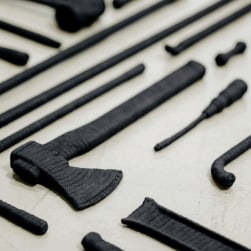
Cinthia Marcelle
To Come To
20 March - 25 April 2009
SPROVIERI
27 Heddon Street London W1B 4BJ
Sprovieri is pleased to present Cinthia Marcelle’s first exhibition in London of new work titled To Come To. In this video, a yellow earthmover is seen driving in a continuous figure eight formation, lifting red soil from one loop and displacing it to the other. Recalling the movement of sand in a horizontally placed hourglass, the trail it creates is both infinite and contained. In common with Marcelle’s video work, To Come To is shot from above - a view that allows the action to be read as image. In the exhibition that takes its title from this work, Marcelle’s imaginary perspective of a world viewed from above connects to a contradictory condition of contemporaneity. Our localised actions are inextricably linked to a global predicament and we imagine ourselves as part of a shared world, yet universal systems to measure that world prove unsustainable.
Marcelle has installed provisional means of division and measure to adapt and expand the gallery. Temporary, a yellow painted hoarding, divides the space into two rooms. This allows the video work to be placed within an intricate narrative that is played out as the viewer moves from the entrance to the far end of the space - where another new work entitled In So Far As is installed. This work, conceived to adapt to any spatial specificity from a distance, takes the form of a flexible wooden ruler 360 centimetres in length, a device invented for flat surfaces bending into a curved measure of the height from ceiling to floor.
Explanation meanwhile is composed of lengths of masking tape ripped from a roll and repaired, with small gaps, into lines that form a brick-wall against a white background. This is part of an ongoing series in which Marcelle’s day-to-day work of gesture is built up into a warning against the barriers imposed by explanation. As a counterpoint, two smaller works from the series Just in Case form broken walls and point to the antonymous process of taking things apart and allowing alternative points of view to break through. Here the pairing of these two works recalls the circular action of excavation and accumulation carried out by the earthmover.
The particular yellow of Temporary is universal in its association with construction; it is a colour that indicates people at work, one that marks out the margins of roads and distinguishes industrial vehicles from everyday traffic. Connecting an industrial-scale understanding of labour to her smallest scale processes, Reel to Reel is an adapted tape recorder made in collaboration with Tiago Mata Machado. Loaded with masking tape, it amplifies the sound of Marcelle’s own gestural work - emitting the noise of adhesive tape pulling away as it turns.
In a practice that is itself expansive but consistent in its inquiries, Marcelle focuses upon worlds that are differentiated but common - from particular forms and colours to the dispersed day-to-day activities contained by the world of manual labour. Individuals or things that are normally spread out are condensed into collected objects or collective actions, accumulating from displaced margins into powerful temporary centres. A preoccupation with the force of simultaneous action is explored within an ongoing series called Unus Mundus, one element of which reappears as a final note to Marcelle’s Sprovieri Progetti exhibition. In the 2004 installation Historia, Marcelle asked 44 individuals to bring an object in need of repair to the Museu de Arte Moderna da Pampulha (Belo Horizonte, Brazil). Each object was restored by gallery technicians, displayed as a temporary museum collection, and then returned to its owner-lender. Marcelle has transformed single polaroid images of each broken object into multiple prints, which are then slowly recalled into her practice as each object discovers coincidental associations with new work. The image selected for this exhibition shows a model globe appearing to fall into two precariously hinged halves, the surface map of the world having come temporarily unstuck.
Isobel Whitelegg, TrAIN, University of the Arts London




